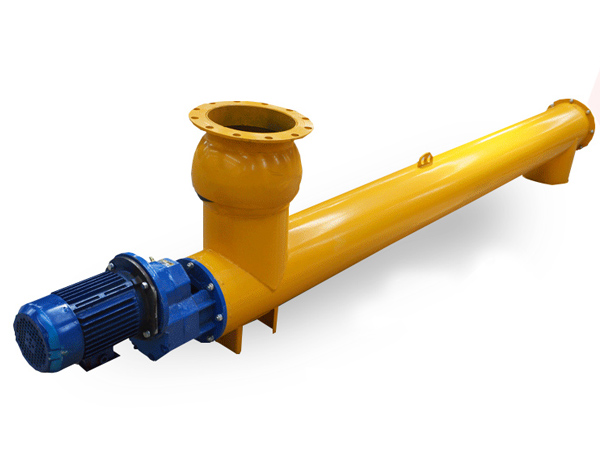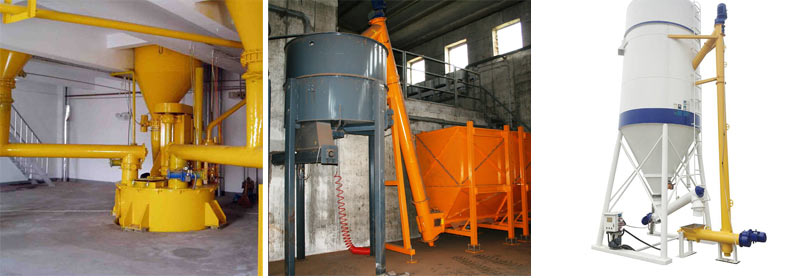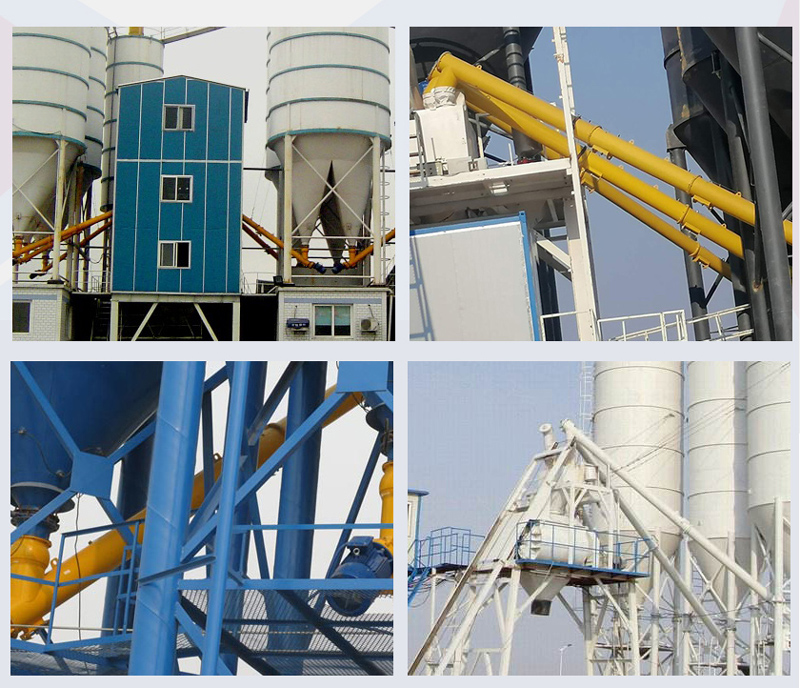
Cement Screw Conveyor
It is used in stone processing plants or concrete conveying plants to convey cement and other raw materials into mixing stations, silos or for proportioning. It is completely sealed and has a large conveying capacity.
Conveying length: 12-16 meters
Conveying capacity: 20-110 tons/hour
Motor power: 2.2-30KW
Cement screw conveyor is mainly used for conveying or feeding cement and cement-like materials in concrete batching plants and other building material processing plants
Introduction of Cement Screw Conveyor
Cement screw conveyors are mainly used for conveying or feeding cement and cement-like materials in concrete batching plants and other building material processing plants. It is a conveying machine that uses a rotating continuous spiral blade belt to push materials in a closed tube.
Whether it is horizontal or large inclination conveying, cement screw conveyor can be directly connected and fixed with its supporting equipment, with good sealing, no water seepage and material leakage.
Function of Cement Screw Conveyor
Cement screw conveyors are mainly used to transport bulk materials such as cement, fly ash and mineral powder.
Features and Benefits

1. The use of reducer heavy equipment has the characteristics of large torque and low noise.
2. The high-precision continuous seamless spiral blades of the cement screw conveyor after cold-working and hardening have an outer edge hardness of HB240, small pitch error and high dynamic balance accuracy.
3. There are various interface connection methods such as spherical hinge, nozzle, flange and square flange for the inlet and outlet.
4. There is an anti-seepage device at the connection of the shell pipe, which can avoid the cement agglomeration caused by the infiltration of rainwater outdoors, which will cause material blocking and boring events.
5. Each transmission part adopts floating connection, so that the spiral body, the hanging bearing and the tail form a suspended body, and no material is stuck or blocked.
6. The suspended intermediate hanging bearing frame increases the material transportation space and reduces the logistics resistance. Coupled with the design of small diameter, high speed and variable pitch, it ensures smooth, fast and even feeding.
Structure of the Cement Screw Conveyor

Cement screw conveyors are composed of electric motor, reduction box, input section assembly, intermediate section and intermediate support body assembly, output section assembly, front support body assembly, oil filling and lubrication system, and accessories are cables, connection canvas covers, It is composed of wire rope and accessories for hanging.
Motor: large torque, reliable and durable, matched with imported bearings, long service life.
Reducer: It adopts high-quality reducer, heavy-duty design, and has the characteristics of large torque and low noise.
Spiral blade: continuous spiral blade made of high-strength wear-resistant steel. After forming, the pitch error is less than 5mm and the blade surface is smooth, which ensures the uniformity and stability of material conveying, thus ensuring the repeatability of material measurement. The surface cold rolling treatment of cold work hardening is adopted during manufacture, and the hardness and wear resistance are about doubled compared with ordinary blades, and the outer edge hardness can reach HB240.
Connection method: Universal ball, cloth bag, flange and other connection methods, the user can choose freely.
Technical Parameters
| Name | LSY100 | LSY120 | LSY140 | LSY160 | LSY200 | LSY250 | LSY300 | LSY400 | ||
| Shell tube diameter(mm) | Φ114 | Φ133 | Φ168 | Φ194 | Φ219 | Φ273 | Φ325 | Φ402 | ||
| Allowable working angle(α)) | 0°~60° | 0°~60° | 0°~60° | 0°~60° | 0°~60° | 0°~60° | 0°~60° | 0°~60° | ||
| Delivery capacity(m) | 8 | 10 | 12 | 14 | 15 | 18 | 20 | 25 | ||
| Delivery capacity(t/h) | 6 | 12 | 17 | 28 | 45 | 70 | 130 | 150 | ||
| Motor | Model | L≤7 | Y90S-4 | Y100L1-4 | Y100L2-4 | Y132S-4 | Y132M-4 | Y160M-6 |
Y160L-4 Y180M-4 |
Y180L-4 |
| Power KW | 1.1 | 2.2 | 3 | 5.5 | 7.5 | 11 | 15-18.5 | 22 | ||
| Model | L>7 | Y100L1-4 | Y100L2-4 | Y112M-4 | Y132M-4 | Y160M-6 |
Y160L-4 Y180M-4 |
Y180M-4 Y180L-4 |
YH200L-4 | |
| Power KW | 2.2 | 3 | 4 | 7.5 | 11 | 15 | 18.5-22 | 20-30 | ||
The cement screw conveyors produced by Dahan Company are available in various models, and we can also customize them according to your needs.
Selection skills of cement screw conveyor
1. Conveying capacity: Conveying capacity demand determines the pipe diameter and motor power of the conveyor. According to different conveying capacity demand, the required screw conveyor model can be roughly estimated;
2, transmission Angle: in theory, cement screw conveyor can achieve 0-60° inclined transmission, but in 45° above the transmission capacity will have a more obvious weakening, the need to adjust the motor power and spiral speed to ensure the transmission capacity, the specific situation needs to be calculated;
3, transmission distance: from the motor to the other end, the motor pulling ability of the helical stranding dragon will gradually weaken, the longer the transmission distance, the larger the diameter of the pipe, the weaker the force is more obvious, so the moderate transmission distance and matching motor power, can also ensure good concrete transmission efficiency;
4. Feed flow: cement screw conveyor feed flow size is another factor to ensure the throughput and machine life, too little feed easy to lead to spiral idling, too little feed easy to cause timely delivery and blockage, will greatly reduce the service life of cement screw conveyor, so in the selection of the model, to consider the feed flow or adjust the feed flow after selection;
5. Connection form: depending on the frequency of disassembly, choose universal ball (relatively fixed) connection or bag soft connection (frequent disassembly).
In addition, the material of cement screw conveyor is generally Q235 carbon steel, if you have special needs you can also customize the material, color or other aspects.
Application

Cement screw conveyors are specially used for conveying or conveying cement and filler dust in concrete batching plants, cold filler dust in asphalt mixing plants, and cement and similar materials in building material processing plants.
Solutions by Industry


